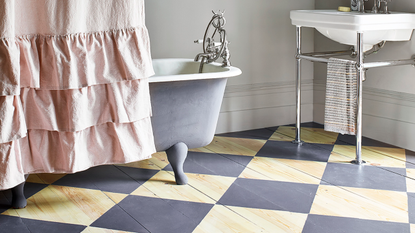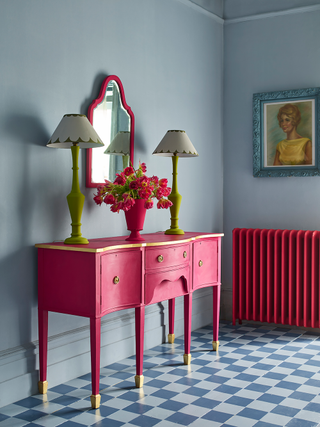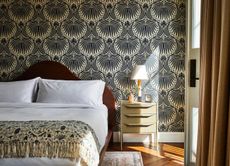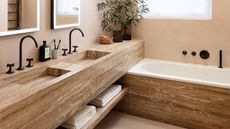How to paint a checkerboard floor – a step-by-step guide to putting a classic twist on your space
Our experts give their tips and trick on how to paint a checkerboard floor to dramatically transform a blank canvas

If you want to introduce more timeless interior trends into your home, our tutorial on how to paint a checkerboard floor will help you do just that. A checkerboard floor can add a sleek and stylish feel to a multitude of spaces, and you don't necessarily have to rip up your current floors to achieve the look.
'Creating a feature of your floor is an easy yet impactful way to immediately and dramatically change the look and feel of a space,' says Ruth Mottershead, creative director of Little Greene. Checkerboard floors are a great idea for a feature floor in areas like your hallway, bathroom or kitchen. They don't always have to be black and white either – you can incorporate different paint ideas into this trend to best suit your interior.
If you want to refresh your floors to have them be the focal point of your room, we've got the perfect DIY guide for you. Here, the experts tell us their top tips when it comes to recreating the trend yourself, with a step-by-step guide on how to paint a checkerboard floor.
How to paint a checkerboard floor
To create the perfect checkerboard floor, you will need:
- Masking tape
- Pencil
- Paint brush
- Paint roller or paint pad
- Primer
- Sander (handheld electric or rented)
- Wood filler
- Filling knife
- Masking tape
- Square stencil in the size of the checkerboard pattern you wish to create
- Sealant
1. Choose the right paint
The first thing you'll want to do when planning to paint a checkerboard floor is decide on your colors. Ruth Mottershead, creative director at Little Greene, says: 'To create a checkerboard pattern, first select your color palette, paint out paint samples on paper and place them on the floor in different areas of the room to see the effect light and shade will have on the colors.'
You can experiment when it comes to color combinations you want to use in your pattern. 'For an impactful finish, opt for highly contrasting colors,' says Ruth. 'Or for a more subtle look, use tonal colors.'
When painting a floor, however, your chosen paint should be durable and hardwearing, suitable for high-traffic areas so that it'll last. Specialist floor paints are available, giving the toughest paint finish possible, but a woodwork paint with a matt varnish will also be durable enough.
2. Prepare the surface
Before taking steps to paint anything in your home, it's always important to prepare your surface to create as smooth a finish as possible. First start by vacuuming and cleaning the floor, ensuring it's dry. If your flooring currently has a glossy or varnished finish, sand the floor first so that the paint can adhere well to the surface. If you have a reasonably small space to work with, you can use a handheld electric sander to achieve this easily enough – this is also best to get around the edges. However, if you're working with a much larger space, you might benefit from hiring a floor sander to get it done more quickly.
Here's how to paint wooden floorboards to get you started. Fill in any dents, scratches or knot holes with wood filler and sand down these areas down. Make sure to clean up the sawdust from sanding before applying any primer or paint.
Depending on the paint you've chosen for the floor, you may need to prime the floors before painting. It's also recommended to prime to surface if it's been sanded. Ruth Mottershead at Little Greene says: 'For softwoods, knots should be sealed with Wood Primer to prevent staining.' Apply the primer following the instructions on the tin.
3. Paint your base color
Now it's time to paint - remember the rules of how to paint a room though. If you're also painting the ceiling and walls, the floor should be completed last.
Ruth at Little Greene recommends using your lighter color first as the base. Start by cutting in with a paintbrush – this means painting the edges around the room. If your base color is different from your trim color, use masking tape to cover the bottom of your skirting boards so you avoid getting paint on them.
Then, using a roller, paint the rest of the floor. You may wish to use a roller with an extension pole so you can stand up and paint, or use a kneeling pad to support your knees.
A great tip is to start at the furthest point from the entryway to the room so you don't get stuck in a corner with no option but to walk over your wet paint.
Allow the base to dry completely before applying the tape for your checkerboard pattern.

4. Plan and sketch out your pattern
The trickiest part of painting a checkerboard floor is getting the pattern right. 'Don’t forget to consider the direction of your squares,' says Ruth at Little Greene. 'Keeping them straight and in line with walls works brilliantly in homes where the walls are very straight, but if you live in a period property or have an unusually shaped room, consider twisting the squares to create a diamond effect checkerboard floor. This will be far more forgiving when it comes to uneven walls and angles.'
Once you've decided how your checkerboard pattern will look, you can start drawing it out. 'Get a pencil and draw out the guidelines before applying masking tape,' recommends color and paint expert Annie Sloan.
Using a square template in the size of the checkerboard pattern you want to create will be helpful to draw around, ensuring each square is the same size. Try using a peel-and-stick tile, or cut one out yourself from cardboard. Ruth says: 'The beauty of painting your own checkerboard is that your squares can not only be any color you wish, but they can also be any scale you wish, too.' There are so many floor paint ideas out there you can use to inspire your checkerboard pattern.
Once you have drawn the first square outline, apply masking tape along the outer edges of your pencil lines. 'To get really crisp clean lines on your checkerboard floor, use a good quality masking tape,' adds Ruth.
Continue drawing and masking out your checkerboard pattern until you have filled the space you wish to paint. If you're mapping your squares out straight in line with your walls, mark every other square with a small piece of tape so you know which ones you're not going to paint to avoid any confusion. If you're angling the squares in a diamond shape, do this same process by facing the corner of the room so that you're looking at the checkerboard pattern as squares and move diagonally down the room, marking every other square.
5. Paint the pattern with your second color
Now it's time to get your second color ready to paint the unmarked squares. 'Paint the darker color into the masked squares, removing the tape whilst the paint is wet and then allow to dry,' recommends Little Greene's Ruth Mottershead.
If you can get through the painting quickly, you may wish to remove the tape all at once at the end if the paint is still wet. But if the space is larger and the process is taking longer, then remove sections of the masking tape as you go, ensuring to also carefully peel off the pieces of tape on the squares you haven't painted once you've completed that area. Do not leave the masking tape on overnight, as the longer it stays on as the paint dries, the trickier it will be to remove.
Depending on the size of the squares, apply the paint with either a roller, a paint pad or a brush – whichever works best for you. Annie Sloan says: 'Using the correct brush will help, too. A small brush with flat edges will help keep sharp lines.'
6. Seal your floor
Depending on the type of floor you're painting and the paint you've used, you may need to seal the floor. Check on the paint tin to see what is recommended.
Sealing your floor can add an extra layer of protection to a high-traffic area, preventing scuffs and scratches. Wood and concrete are naturally porous, so sealing these kinds of floors can also prevent staining, waterproof them, and generally make cleaning easier, particularly if you're painting the floor of your kitchen or bathroom.
There are several different types of sealant available, depending on your floor and paint. Polyurethane, polyacrylic and wax sealants are all available in clear coats, but it's important to read each product to check if it's suitable for your needs. Apply to your floor according to the directions, and make sure the paint is dry and your floors are clean before this to ensure no dust or debris gets trapped under the sealant.
What goes with a checkerboard floor?
A checkerboard floor will be a stand-out feature in any room. Depending on the color scheme you use, there are many ways to style a room around a checkerboard floor. If you use for subtle, soft tones, you can perhaps incorporate bolder colors into other areas of the room. For example, a soft but statement color on your walls or on the cabinets in your kitchen.
In a bathroom, bold and classic black and white checkerboard floors are complemented beautifully by more traditional bathroom suites. Keep your wall colors light and neutral and perhaps use smaller gold accents throughout the room on hardware such as drawer handles. A minimal color scheme will allow your checkerboard floor to look timeless and elegant without overwhelming the room.
Be The First To Know
The Livingetc newsletter is your shortcut to the now and the next in home design. Subscribe today to receive a stunning free 200-page book of the best homes from around the world.
Georgina Crothers is a trainee lifestyle journalist currently studying MA Magazine Journalism at City University of London, having written for Tesco Magazine and Crime Monthly. Aspiring to write home and interiors content once her degree is finished, and as a novice DIYer, you’ll often find her bingeing home renovation and furniture flipping TikToks, searching YouTube for the perfect DIY tutorial to revamp her own living space.
-
 Where to Spend Your Bedding Budget — Experts Say This Is Where They Splurge and Where They Save
Where to Spend Your Bedding Budget — Experts Say This Is Where They Splurge and Where They SaveWe’ve consulted bedding experts for their advice on the bedding items you should – and where you definitely should not – be spending your bedding budget
By Marina Rabin Published
-
 How to Wash a Bath Mat — It's Easier Than You Think With These 5 Simple Steps
How to Wash a Bath Mat — It's Easier Than You Think With These 5 Simple StepsEasy-to-follow tips from experts on cleaning bath mats in the best way
By Faiza Saqib Published